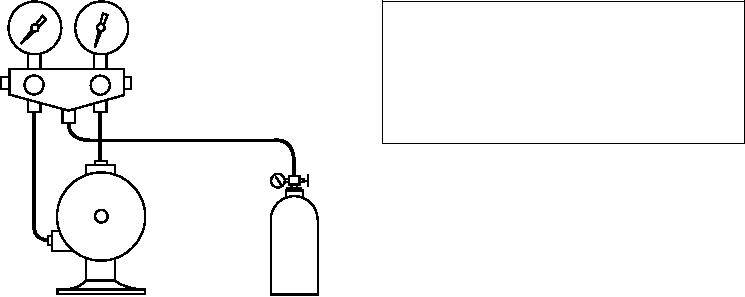
CAUTION
In low-side charging, be sure that the refrigerant
LO
HI
cylinder is kept in the vertical position at all times
to keep liquid refrigerant from entering the com-
pressor.
HIGH-SIDE (LIQUID) CHARGING.--In
high-side charging, you charge the receiver with liquid
refrigerant by using the following procedures.
1. Connect a hose between the center connection
of the manifold test set and the cylinder of refrigerant
(fig. 11-29, view A). If using a single port/single access
valve cylinder, the cylinder should be in the upright
REFRIGERANT
COMPRESSOR
position at this point in the procedure. Tighten both
ASf11028
connections.
Figure 11-28.--Connections for low-side charging.
2. Connect a hose from the high-pressure side of
the manifold test set to the receiver inlet valve. The
should be in the back-seated position (servicing gauge
service valve on the receiver should be in the
port closed). Leave a loose connection at the
back-seated position (servicing gauge port closed).
compressor.
Leave a loose connection at the service port.
3. Connect a hose from the high-pressure side of
3. Open the valve on the cylinder of refrigerant.
the manifold test set to the discharge side of the
The cylinder should still be upright.
compressor. The service valve on the compressor
should be in the back-seated position (servicing gauge
4. Crack the high-pressure valve on the manifold
port closed). Leave a loose connection at the
to bleed the air from the hose. When refrigerant starts to
compressor.
escape from the service port, tighten the fitting, and
close the manifold valve.
4. Open the valve on the cylinder of refrigerant.
5. Set the receiver inlet valve to the mid-seated
5. Crack the low-pressure valve on the manifold
position. This opens the servicing gauge port.
to bleed the air from the hose. When refrigerant starts to
escape from the suction port, tighten the fitting, and
6. Invert the cylinder of refrigerant, and hang it
close the manifold valve.
from a scale (fig. 11-29, view B). Record the weight of
the cylinder. (You will normally have a hanging scale
6. Crack the high-pressure valve on the manifold
available for this purpose, but, alternatively, you can
to bleed the air from the hose. When refrigerant starts to
use a platform scale.)
escape from the discharge port, tighten the fitting, and
close the manifold valve.
NOTE: In charging with liquid refrigerant, you
monitor the weight of the refrigerant that is transferred
7. Set both service valves on the compressor to
to the air-conditioner. Starting from empty, the
the mid-seated position. This opens the servicing gauge
A/M32C-17 should take a charge of 117 to 120 pounds
ports.
of refrigerant. Tanks of refrigerant are normally 50 to
8. Open the low-pressure side of the manifold test
80 pounds, so it will take more than one tank to fill the
set.
receiver of the air-conditioner.
9. Start the compressor. Refrigerant will be drawn
7. Open the high-pressure valve on the manifold
from the storage cylinder to the suction side of the
to start the flow of refrigerant from the cylinder to the
compressor. Add the refrigerant slowly, checking
receiver.
regularly until the system is fully charged. The system
8. When you calculate that the proper amount of
has a liquid-line sight glass, and the system is fully
refrigerant has been transferred, close the valves on the
charged when there is no bubbling of refrigerant as it
cylinder, the manifold, and the receiver.
passes the glass. The sight glass will appear empty.
11-30

